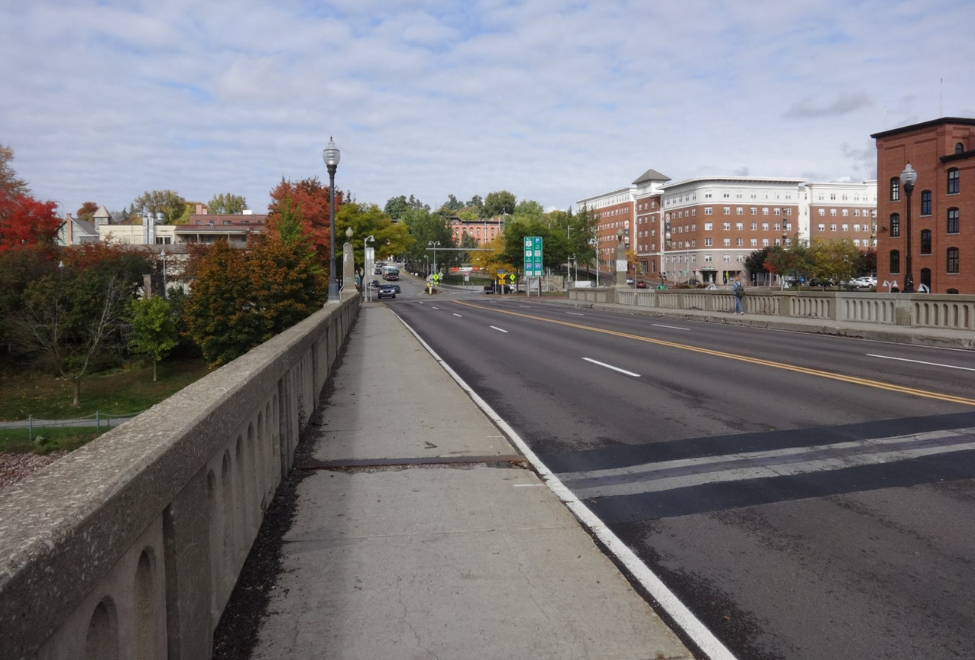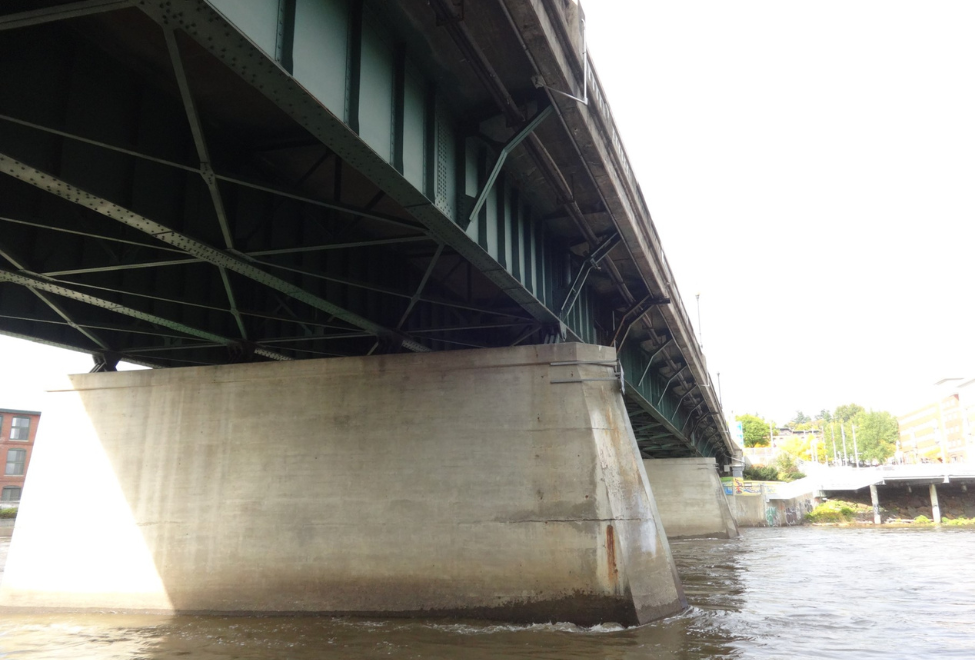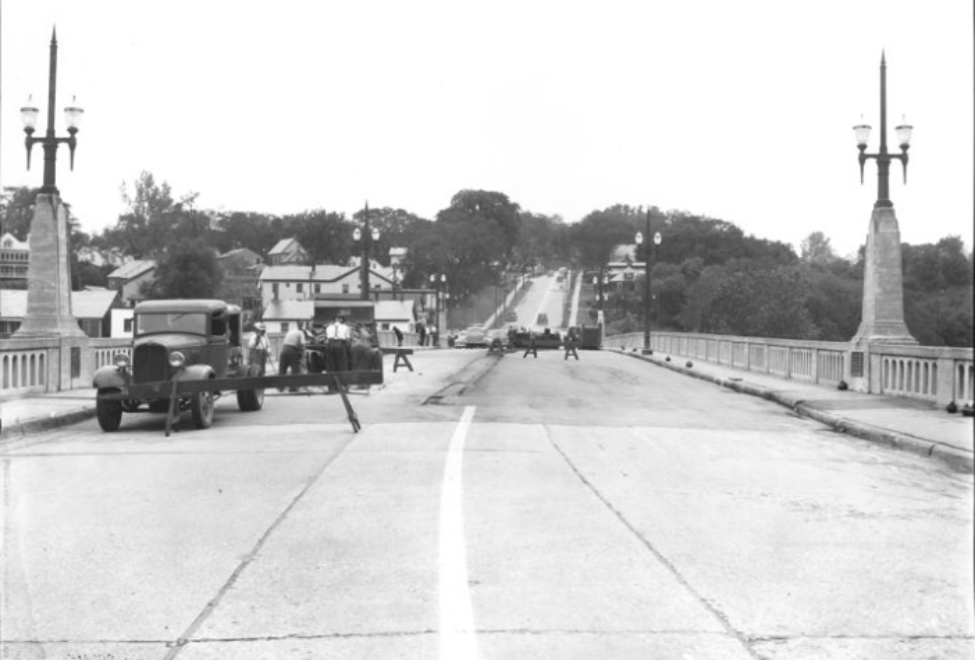Existing Conditions of the Bridge
The Burlington-Winooski Bridge is the only direct connection between Burlington and Winooski - two of Vermont's most densely populated cities, making this bridge a piece of critical infrastructure to support transportation within the communities. Originally constructed in 1928, the existing bridge is reaching the end of its service life. The existing three-span steel girder structure features narrow 10.5-foot vehicle travel lanes, no shoulders, narrow 6-foot sidewalks, no dedicated bicycle facilities, and no physical separation among various modes of transportation - all of which create a barrier to safe and efficient multimodal transportation.
Recognizing the change in modes of transportation since the original construction and the structure's upcoming maintenance needs, an alternatives evaluation was commissioned between 2017 and 2019 to identify a path forward. Through the robust evaluation of alternatives, a decision was made to replace the bridge. This decision was made with an understanding of the current bridge condition, its safety, and the time necessary to develop and construct the replacement bridge.
VTrans routinely inspects the bridge in accordance with the National Bridge Inspection Standards (NBIS) to ensure continued safety for users of the bridge. While the new bridge is being designed and constructed, the current bridge will continue to be inspected. Based on a 0 - 9 numeric rating scale, the 2023 bridge inspection of the Burlington Winooski bridge resulted in the following condition ratings:
- Deck Rating: 5 (Fair Condition)
- Superstructure Rating: 6 (Satisfactory Condition)
- Substructure Rating: 7 (Good Condition)
The inspection report indicates that the Burlington-Winooski bridge is structurally safe and poses no threat to the traveling public. In addition to the inspection report, a capacity (load rating) evaluation has occurred and indicates the bridge is structurally capable to support modern vehicle loads. However, due to the age of the structure, maintenance/rehabilitation needs, and narrow bridge width that no longer meets the needs of the community, a plan to replace the bridge is moving forward.
The proposed improvements to this critical community connection will significantly improve the mobility of vehicular traffic and active modes of transportation, thereby removing the barrier that the existing structure presents to safe and equitable multimodal transportation.

View of the top portion of the existing bridge (2023).

View of the underneath portion of the existing bridge (2023).
History of this Crossing
A bridge spanning the Winooski River has linked the communities of Burlington and Winooski at this site for over 200 years. In the late 1800s, one of the bridges constructed at this crossing featured a two-lane design intended for horse-drawn carriages, accompanied by two separated pedestrian footpaths. This bridge was later replaced by a two-span truss bridge, featuring two pedestrian sidewalks and a shared travelway that accommodated trolleys and vehicles, reflecting the increased use of automobiles and rail transit in the early 20th century. Multiple bridges at this location have served the needs of residents by adapting to changing transportation modes over the years.
A generational flood event in November 1927 washed away the previous truss bridge. Following the washout, and due to the importance of this river crossing to the two communities, a temporary pontoon bridge was installed to maintain the critical connection and allow daily life to continue with limited disruption while a new bridge was built (1). Nine months later, in August 1928, construction of the current bridge was completed to support a trolley line, two lanes for vehicles, and sidewalks (2). This rapid bridge replacement is a testament to the importance of the connection between the two communities then, as it is today. As trolley use declined and the popularity of personal vehicles increased, the trolley tracks were removed, and the bridge was repurposed to support four lanes of vehicle traffic (4).
The Historic Resources Identification Report and the Archaeological Resources Assessment present further information on the history of this crossing and the surrounding area. The following images are housed at the University Vermont Libraries Digital Collection.

1. In 1928, construction on the new Burlington Winooski bridge began. Construction workers can be seen on the steel beams (McAllister, 1928).

2. The reopening of the bridge was a big event for the two cities. Marching bands played on both sides of the bridge to celebrate reopening such a vital connection between Burlington and Winooski (McAllister, 1928).

3. October 1929. View from Colchester Avenue near Barrett Street, looking at the bridge over to Winooski (McAllister, 1929).

4. 1945. View toward Burlington Avenue and Colchester Avenue. Trucks and workers are completing repairs on the bridge (McAllister, 1945).
Photo credits:
1. McAllister, L. L. (1928). Winooski Bridge Construction [Photograph]. University of Vermont Libraries. Special Collections. https://cdi.uvm.edu/uvmcdi6251
2. McAllister, L. L. (1928). Winooski Bridge Opening Ceremonies [Photograph]. University of Vermont Libraries. Special Collections. https://cdi.uvm.edu/uvmcdi6271
3. McAllister, L. L. (1929). Winooski [Photograph]. University of Vermont Libraries. Special Collections. https://cdi.uvm.edu/uvmcdi6242
4. McAllister, L. L. (1945). Winooski Bridge Repair [Photograph]. University of Vermont Libraries. Special Collections. https://cdi.uvm.edu/uvmcdi12293
